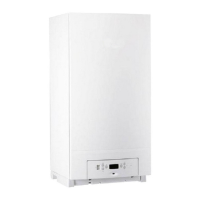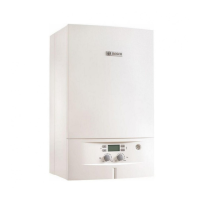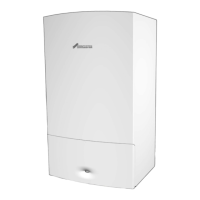Commissioning
29
Condens 7000 FP – 6721846699 (2022/12)
7.6.2 Checking the flue gas damper (scope of delivery of flue gas
cascade set)
When using motorised flue gas dampers the closing function must be
checked. The damper is closed in the electrically de-energised state.
Check function of flue gas damper:
Open flue gas damper manually via the setting pin (from position 1 to
position 2).
The function exists if the damper closes automatically (pin in position
1).
Fig. 35 Setting pin on the butterfly valve
[1] Position 1: damper closed
[2] Position 2: damper open
7.7 Making the heating system operational
Open the fuel supply at the main shut-off valve and upstream of the
air/gas ratio control valve.
Switch on the heating system emergency stop switch (if installed)
and/or the corresponding domestic fuse/circuit breaker.
7.8 Commissioning the control unit and burner
7.8.1 Switching on the boiler at the control unit
To commission the control unit, observe the technical
documentation for the specific control unit.
To avoid frequent cycling of the burner and to ensure efficient operation,
the heating curve should generally be set as low as possible.
7.8.2 Carrying out a flue gas test
To set up and perform the flue gas test, observe the corresponding
technical documentation for the control unit.
7.9 Measuring the gas supply pressure and static
pressure
Release the locking screw of the gas supply pressure and ventilation
test nipple ( Fig. 34, [1], page 28) by turning it through 2
revolutions.
Push the test hose of the pressure gauge (measurement precision
less than 0.1 mbar) onto the pressure test nipple.
With the burner operational (full load), check the gas supply pressure
and record the value in the commissioning report ( Chapter 17.6,
page 72).
If the gas supply pressure falls outside the values in table 10
Shut down the floor standing boiler and notify the gas supplier.
Commissioning is not permitted.
To check the gas pressure regulator or the gas static pressure in the gas
installation:
Shut down the burner from full load.
Wait 10-20 seconds and then measure the resulting gas supply
pressure/static pressure at the test nipple for the gas supply
pressure/static pressure.
The gas static pressure must not exceed 50 mbar.
If exceeded:
Inform the gas supplier that the gas pressure governor needs to be
replaced.
Do not perform commissioning in accordance with the
manufacturer's instructions.
If the system is currently in operation, take the floor standing boiler
out of operation.
Remove the test hose.
Carefully tighten the locking screw on the test nipple for gas supply
pressure.
Table 10 Gas groups and supply pressures according to EN 437
The specified supply pressure must be ensured across the boiler's entire
modulation range. If necessary, an additional pressure regulator must be
provided. In the case of multi-boiler or multi-consumer systems, the
supply pressure range for single boilers must be ensured in each
operating condition of the multi-boiler or multi-consumer system. If
necessary, supply each boiler or consumer via a separate pressure
regulator.
Country Gas group
(reference gas)
Supply pressure
1)
[mbar]
1) The gas supplier must ensure that the pressure conforms to country-specific
or local regulations. The conditions mentioned above must also be observed.
If the gas supply pressure is outside the specified range, commissioning is
prohibited.
Min. Rated Max.
AT, BE, BG, BY,
CH, CZ, DE, EE,
ES, GB, GR, HR,
IE, IT, KG, KZ,
LT, LV, MK, NO,
PT, RO, RS, RU,
SI, SK, TR, UA,
UZ
Natural gas H (G20) 17 20 25
HU Natural gas H (G20) 18 25 33
DE
2)
, LU, NL
2)
,
PL
2) Natural gas group "H according to DVGW Code of Practice G 260" falls within
natural gas group "E according to DIN EN 437". Natural gas group "L according
to DVGW Code of Practice G 260" falls within natural gas group "LL according
to DIN EN 437".
Natural gas E (G20) 17 20 25
FR, BE Sub-group ES
Natural gas E (G20)
17 20 25
FR, BE Sub-group Ei natural
gas E (G25)
20 25 30
NL
3)
3) Natural gas group K according to “NTA 8837-2012” falls within the 2nd gas
family according to DIN EN 437.
Natural gas K
(G25.3)
20 25 30
DE
2)
Natural gas LL (G25) 18 20 25
PL Natural gas Lw
(G27)
16 20 23
HU Natural gas S
(G25.1)
18 25 33

